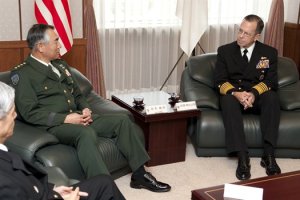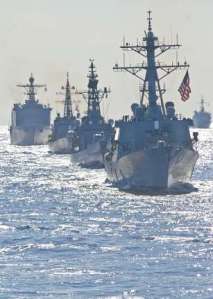Rick Rozoff
Last week Secretary of State Hillary Clinton summoned her Japanese and South Korean counterparts, Foreign Ministers Seiji Maehara and Kim Sung-hwan, to Washington for trilateral talks on the Korean crisis in an open affront to China and Russia, which had called for a resumption of six-party discussions with both Koreas, themselves, the U.S. and Japan.
Officiating over the December 6 gathering with her junior partners on her own turf, Clinton - rather than the foreign ministers of the two East Asian nations - stated, "North Korea's provocative and belligerent behavior jeopardizes peace and stability in Asia." The imperial metropolis and its would-be global procurator pronounce on what constitutes threats to peace and stability on another continent; the perspective of countries in the region like China and Russia don't need to be taken into account and their concerns don't need to be addressed.
Admiral Mullen and General Oriki in earlier meeting
Two days later America's top military officer, chairman of the Joint Chiefs of Staff Admiral Michael Mullen, was in the South Korean capital and in that of Japan the day after. In Seoul he met with General Han Min-koo, chairman of the South Korean Joint Chiefs of Staff, and in Tokyo with Defense Minister Toshimi Kitazawa and Japanese Self-Defense Force (JSDF) chief of staff General Ryoichi Oriki. While in Japan, Mullen mentioned "the trilateral meeting on the part of our foreign ministers which occurred earlier this week in Washington" by way of indicating that his efforts paralleled those of Clinton. Soft versus hard power in the Washington vernacular, both serving the same ends.
He also assured his Japanese opposite number General Oriki that "the United States is very much --" is very involved in regions all over the world but none so much as this one in terms of its importance and its commitment." [1]
Keen Sword 2011
As the two top military commanders met, their armed forces were completing the eight-day Keen Sword 2011 war games which involved "units from the U.S. Army, Navy, Air Force and Marine Corps, working side-by-side with their JSDF counterparts at military bases throughout mainland Japan, Okinawa and in the waters surrounding Japan." [2]
The exercise, the largest military undertaking conducted jointly by the two nations, included 44,000 troops, 400 aircraft and over 60 ships, including the USS George Washington nuclear-powered aircraft carrier accompanied by carrier and expeditionary strike groups.
In the words of a BBC correspondent aboard - and much enamoured with - the supercarrier, "The USS George Washington itself is like a floating city, with 5,500 men and women living on board, 60 aircraft and two nuclear reactors which could allow it to stay at sea for 25 years without coming ashore." [3]
(Note: You can view every article as one long page if you sign up as an Advocate Member, or higher).






